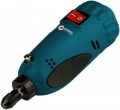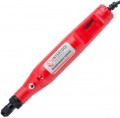Rotation speed
The speed of rotation of the working nozzle provided by the tool. Some models have a fixed rotation speed, others allow you to adjust it within a certain range (see "Number of speeds").
For different types of tools and types of work, different values of this parameter will be optimal; therefore, it is worth choosing taking into account the tasks that are planned to be solved using the tool (it is best to consult with special sources). We note only a couple of general patterns. So, for engraving on relatively soft and pliable materials (wood, glass, soft metals), high speed is not required, but for hard and difficult to process (steel, precious stones), a high-speed tool is better suited. But when drilling, note that for the same power consumption (see above), more revolutions, usually, means lower torque values. That is, here “high-speed” tools are better suited just for soft materials, and low-speed tools are better suited for hard and heavy materials.
Collet diameter
The diameter of the collet provided in the design of the rotary engraver (see "Device").
A collet is a specific type of fastening: a split sleeve, the “petals” of which can be compressed and unclenched by twisting / unscrewing the clamp. For a number of technical reasons, this mount is considered optimal for engravers. In order to properly install the working nozzle in such a tool, it is necessary that it fits the diameter of the collet (to be more precise, the mounting size of the nozzle should not exceed this diameter).
Note that there are several standard collet sizes. The most popular is 3.2 mm, but there are other options. And some engravers can be equipped with several mounts of different sizes.
Functions
-
Reverse. Possibility to change the direction of rotation of the working nozzle of the tool. The use of reverse depends on the type of tool and the type of work for which it is used. For example, when drilling, this function can be useful for releasing a jammed drill. And in screwdrivers (see "Interchangeable heads") a change in the direction of rotation is almost mandatory - otherwise it would be impossible to switch the tool from twisting to loosening and vice versa.
-
Speed controller. The ability to smoothly change the speed of movement of the working nozzle (frequency of rotation or vibration). The adjustment itself is used to adjust the tool for different types of materials and work - for different cases, the speed is different. But smooth tuning is good because it allows you to set the required speed as accurately as possible - there are no strictly fixed adjustments in such models, and the operator can choose any option from minimum to maximum. True, a certain skill is required for the effective use of such a tool, but this problem can hardly be called serious even for beginners.
-
Maintain momentum. A function that allows you to maintain a constant speed of rotation of the nozzle, regardless of the load on it. Without special adjustment, at a constant engine power, the rotational speed inevitably drops with increasing load and increases with
...a decrease. And the revs control system monitors the resistance on the nozzle and, if necessary, changes the power in such a way that the rotation speed remains constant. This has a positive effect both on the quality of work and on the service life of the nozzles and the entire tool.
- Soft start. The moment of starting is one of the most difficult in the operation of any electric motor. When the power is connected directly, in the first moments after the start, a high power flows through the windings, which leads to voltage surges in the network; in addition, the beginning of the movement occurs very abruptly, and this is fraught with jerks of the instrument, with the risk of releasing it from the hands with corresponding unpleasant consequences. The soft start function reduces the described troubles, if not to zero, then to a minimum: special circuits limit the starting power and ensure a soft and safe start of movement.
- Brushless motor. The presence of a brushless (brushless) motor in an electric tool. Such motors are noticeably superior to traditional collector motors in terms of efficiency, which makes it possible to significantly reduce energy consumption without sacrificing power; this is especially important for cordless tools (see "Power Source"), where this feature is predominantly found. In addition, brushless motors are less noisy and generate virtually no sparks during operation, making them ideal for working in high fire hazard environments. Their main disadvantages are traditional - the complexity of the design and high price.
— Backlight. The tool has its own lamp to illuminate the place of work. This feature is especially useful when working in low light conditions or in hard-to-reach areas that are otherwise difficult to illuminate. Note that in this case, it is the embedded system that is meant; some models may be equipped with portable lights as separate units, but such lights do not count as lights.
- Display. Own display in the design of the multifunctional tool is designed to visualize customizable parameters, display the battery charge level and display all sorts of related information. The specific implementation of the screen depends on the level of functionality of a specific instrument model.
- Connecting a vacuum cleaner. Possibility of connecting the vacuum cleaner directly to the tool. For this, a special pipe is usually used, one end of which is led to the place of processing, and the actual hose from the vacuum cleaner is connected to the other. Thanks to this, the work becomes much “cleaner”; True, the vacuum cleaner is far from always 100% able to remove sawdust and other waste, but in any case, it at least simplifies subsequent cleaning. The hose nozzle is usually made removable - this allows you to reduce the overall dimensions of the tool in cases where the vacuum cleaner is not needed or is not within reach. Note that before buying a model with this function, you should pay attention to its compatibility with the specific vacuum cleaner that you plan to use.
— Keyless replacement of nozzles. The presence of a clamping tool in the design that allows you to replace working nozzles without using a key. There are many varieties of such clamps, differing in the procedure for use, but they all have one thing in common: the work with the mount is carried out by hand, without the use of keys or other additional devices.Total number of nozzles
The total number of working attachments supplied with the tool.
The abundance of attachments allows the machine to be used with various materials and for various types of work. At the same time, this parameter significantly affects the cost. Therefore, when choosing, you need to proceed from how important a variety of possibilities is for you - so as not to overpay for extra nozzles that turned out to be useless in fact.
Note that this item is indicated only for engravers (see "Device") - for models of other types, specific types of nozzles are given in the corresponding item (see below).
Weight
The weight of the tool can be indicated according to different rules: some manufacturers take into account only the body without a nozzle, others — with a standard working nozzle, for multi-tools (see "Device") the weight of the main unit without a replaceable head, etc. can be indicated. These points are usually specified in the specifications or detailed documentation.
In the case of a power tool, weight has a dual meaning. On the one hand, the smaller it is, the easier it is to hold the unit in your hands during long work and the more convenient it is to carry out fine, accurate processing. On the other hand, a light tool is less stable and has an increased tendency to jerk, which is important under difficult conditions and hard materials.

